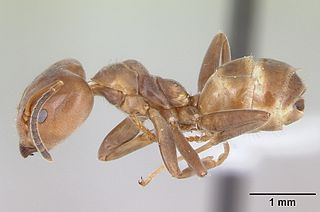
Dolichoderinae is a subfamily of ants, which includes species such as the Argentine ant, the erratic ant, the odorous house ant, and the cone ant. The subfamily presents a great diversity of species throughout the world, distributed in different biogeographic realms, from the Palearctic, Nearctic, Afrotropical region and Malaysia, to the Middle East, Australian, and Neotropical regions.

Crematogaster is an ecologically diverse genus of ants found worldwide, which are characterised by a distinctive heart-shaped gaster (abdomen), which gives them one of their common names, the Saint Valentine ant. Members of this genus are also known as cocktail ants because of their habit of raising their abdomens when alarmed. Most species are arboreal (tree-dwelling). These ants are sometimes known as acrobat ants.

Pseudomyrmex is a genus of stinging, wasp-like ants in the subfamily Pseudomyrmecinae. They are large-eyed, slender ants, found mainly in tropical and subtropical regions of the New World.

Joseph Charles Bequaert was an American naturalist of Belgian origin, born 24 May 1886 in Torhout (Belgium) and died on 12 January 1982 in Amherst, Massachusetts.

Azteca is a strictly Neotropical genus of ants in the subfamily Dolichoderinae. The genus is very diverse and contains around 84 extant species and two fossil species. They are essentially arboreal and many species have mutualistic associations with particular plant species, where the genus Cecropia presents the most conspicuous association. In the Brazilian Amazonia, Azteca species are associated with species of Codonanthopsis.

Technomyrmex is a genus of ants in the subfamily Dolichoderinae. With 98 species, it is one of the largest and most diverse ant genera in the Dolichoderinae. The genus distributed throughout the tropical and subtropical zones with most species occurring in the Oriental-Malesian and Afrotropical regions. One species, Technomyrmex albipes is a tramp ant now widespread throughout the tropics due to human activities.

Azteca adrepens is a species of ant in the genus Azteca. Described by Auguste-Henri Forel in 1911, the species is endemic to Paraguay.
Azteca aesopus is a species of ant in the genus Azteca. Described by Auguste-Henri Forel in 1908, the species is endemic to Brazil.

Azteca alfari is a species of ant in the genus Azteca. Described by Carlo Emery in 1893, the species is widespread in Mexico, Central and South America. This ant has a mutualistic relationship with a Cecropia tree. The specific name alfari honours a Costa Rican zoologist Anastasio Alfaro.
Azteca aurita is a species of ant in the genus Azteca. Described by Emery in 1893, the species is widespread in North America and South America.
Azteca barbifex is a species of ant in the genus Azteca. Described by Auguste-Henri Forel in 1906, the species is endemic to North America and South America.

Azteca chartifex is a species of ant in the genus Azteca. Described by Forel in 1896, the species is endemic to various countries in North America and South America.
Azteca christopherseni is a species of ant in the genus Azteca. Described by Forel in 1912, the species is endemic to Panama.

Azteca coeruleipennis is a species of ant in the genus Azteca. Described by Emery in 1893, the species is endemic to several countries in North America and Central America.
Azteca cordincola is a species of ant in the genus Azteca. Described by Forel in 1921, the species is endemic to Bolivia.
Azteca coussapoae is a species of ant in the genus Azteca. Described by Auguste-Henri Forel in 1905, the species is endemic to Brazil.
Azteca crassicornis is a species of ant in the genus Azteca. Described by Emery in 1893, the species is endemic to Brazil.
Azteca delpini is a species of ant in the genus Azteca. Described by Emery in 1893, the species is endemic to South America.
Azteca depilis is a species of ant in the genus Azteca. Described by Carlo Emery in 1893, the species is endemic to South America.

Azteca muelleri is a species of ant in the genus Azteca. Described by the Italian entomologist Carlo Emery in 1893, the species is native to Central and South America. It lives in colonies in the hollow trunk and branches of Cecropia trees. The specific name muelleri was given in honour of a German biologist Fritz Müller, who discovered that the small bodies at the petiole-bases of Cecropia are food bodies.









